
The Manor of Pirbright
In writing this section we are indebted to the book “Henley Park in Surrey: The History of a Royal Manor” (2012) by John Squier. We also thank the website https://www.british-history.ac.uk/ where further information about medieval Manors can be found.
Introduction
First a bit of scene-setting. What was a manor in medieval times? A Manor was a large estate (ie a piece of land) granted by The King to an individual (who would thus become Lord of the Manor). A Manor House would generally be built as a large, central structure within the manor, and would usually serve as the home of the Lord. It would also be used as the Manorial court, in particular to hold court meetings, where property transactions would be agreed and recorded on a long parchment, called a Court Roll. All self-respecting Manors had an accompanying Park.
Peasants would be allowed to live on land in the manor in exchange for tending their patch. They would have rights over their patch of land. These rights would either be Freehold, Copyhold or Leasehold.
We are familiar with Freehold and Leasehold arrangements today, but Copyhold no longer exists. Copyhold was a little like leasehold. A copyholder, however, normally had the right to pass on the property to their heir (usually the eldest son). In addition to paying yearly rent, the copyholder had to supply labour at harvest time and also pay a heriot in animals or cash and fine when the property was sold or passed to the copyholder’s heirs. Copyhold was phased out in the second half of the 19th century and finally abolished in 1925.
The Manor of Pirbright: Earliest history
The Manor of Pirbright seems to date from sometime in the 1200s. Prior to then, Pirbright was part of King Henry II’s Royal Forest of Windsor. Within the forest, no landowner could build houses, cut trees or undergrowth, carry out ditching, draining or hedging to improve their property.
Under Forest Law, savage penalties were enforced against the killing of the King’s deer, in Pirbright. These animals were kept within a fence called Purbrighte Rayles, whose name still partially exists as Rails Farm. The fence is shown on a 1605 map of Windsor Forest, from which an extract is shown below. Despite some present-day places being identifiable (Purbright, Rickforde Bridge, Worplesdon, Henley Parke), it’s difficult to work out exactly where the fence stood. We think it stretched from today’s Rails Farm across to Bullswater.

Mary Cawthorn in her History of Pirbright (1931) thought that Pirbright may have been alienated from The Manor of Woking via a grant by King Henry I to Richard, 1st Earl of Gloucester in the 1120’s. Possibly, but we do not know for sure. There was also nearby a Manor of Cowshot, comprising, in 1805, 53 acres of land north of the railway and canal, now owned by the National Rifle Association, but about which little is known and no records survive.
By the time of the 1200s the Manor of Pirbright would have been overshadowed by nearby Henley Manor (to the south-west of Pirbright). Henley Manor predated Pirbright Manor by at least 200 years, and its Manor House was well-established by 1340, when King Edward III used it as a hunting lodge. Henley Manor House was large – it had several rooms, a chapel, watchtower and drawbridge, and even a royal park (Henley Park). The site of this Manor House is where the unlovely Henley Business Park stands today.
But returning to the Manor of Pirbright, a park was created in the Manor in the 1200s. However, this was abandoned during the next century. The first mention of a Manor House is in a survey for King Edward I in 1302.
During the course of the next 250 years, the Manor was bestowed by the various monarchs on various different people, who became the Lords of the Manor of Pirbright. Many of these people would not have lived in Pirbright, and some might even not have known where Pirbright was. Some of them met rather grisly ends when they fell out of royal favour.
Edward IV (1461-83) acquired the Manor from his mother, and he re-created the Manor’s original park. We have shown the park’s location in 1805 opposite Pirbright Lodge on the map below, shaded green. The blue areas belonged to the Lord of the Manor (in 1805).
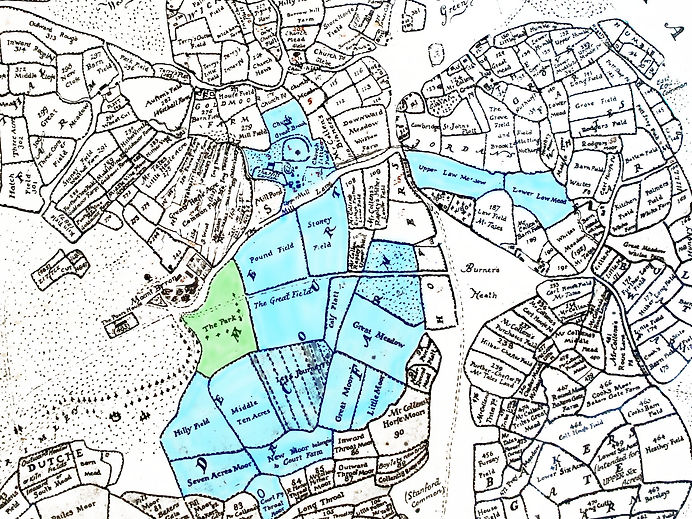
During the reign of Henry VIII (1509-1547) the Manor changed hands several times, ending up (in 1542) in the hands of Sir Anthony Browne, who we will refer to as Sir Anthony Browne 1. Sir Anthony had been appointed to be the keeper of Henley Park in 1516, and his acquisition (probably by royal appointment) of Pirbright Manor in 1542 marked the beginning of a close association between the 2 Manors.
Lords of the Manor of Pirbright post-1542
From 1542 we can track the Lords of the Manor well. They are listed below.
1542 - 1677: Sir Anthony Browne and his descendants (the various Viscounts Montagu).
1677 - 1682: John Glynne 2
1682 – 1702: Dorothy Glynne (wife of John Glynne 2), as guardian of her daughter, Dorothy Glynne (see next line)
1702 - 1739: Dorothy Glynne (daughter of John Glynne above), who married Sir Richard Child, later Earl Tylney of Castlemaine
1739: Purchased by Solomon Dayrolles
1784: Purchased by Henry Halsey 1
1807: Inherited by Henry Halsey 2
1885: Inherited by Henry Halsey 4 (No 3 predeceased his father, No 1)
Henry Halsey died in 1937, with no male heirs and we do not know who acquired the title of Lord of the Manor of Pirbright from him. We think that the title today would not come with any property or other tangible benefits. Perhaps some ceremonial rights, but that is all.
Lords of the Manor of Pirbright post-1542 – more information
Sir Anthony Browne 1 (c1500-1548), who acquired the Manor of Pirbright in 1542, was a close associate of Henry VIII. He had an active military career, and had been rewarded with the keepership of Guildford Park (1511) and the Manors of Cleygate and Worplesdon (1513) prior to being appointed keeper of Henley Park and given the Manor of Pirbright. In 1539 he was appointed to the House of Commons.
He played an active role in the dissolution of the monasteries, and benefitted from the redistribution of monastery lands – today this would be called cronyism, and it gives us a clear picture of how things worked in those times. Henry VIII made him an executor of his will and guardian of 2 of his children. At the time of his death in 1548 Sir Anthony owned nearly 20,000 acres (30 square miles) of land in Surrey and Sussex. A drawing of Sir Anthony is shown below.

We assume that Sir Anthony’s son, who we will refer to as Sir Anthony Browne 2 (1528-92), inherited the title of Lord of the Manor of Pirbright on his father’s death in 1548. He had been elected Member of Parliament for Guildford in 1545 and, under Queen Mary, was in 1553 appointed keeper of Guildford Park. The following year he was appointed Viscount Montagu. He remained loyal to Queen Elizabeth I when she acceded to the throne in 1558 and held various positions until he died in 1592. A portrait of Sir Anthony Browne 2 is shown (right)
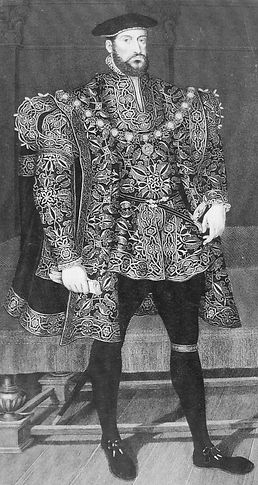
Sir Anthony Browne 2’s eldest son (Anthony Browne 3) died 4 months before his father, and so never inherited his title or the Manor of Pirbright. Instead those honours went to his son, Anthony-Maria Browne (1574-1629), who inherited an income around £4,500 pa (£1.5 million pa today). His most notable achievement may have been to be arrested in connection with the Gunpowder Plot in 1605, then spending about a year in the Tower of London.
His eldest son, Francis Browne (1610-82) then became the 3rd Viscount Montagu and Lord of the Manor of Pirbright in 1629, on the death of his father. In 1631 he sold Henley Park to one Arthur Squibb (c1578-1650), who held senior positions in the Dept of the Exchequer, and then the Office of the College of Arms.
But it seems that he was lacking in the political skills so ably demonstrated by his 2 forebears – he backed the royalists during the civil war (1642-51), and was a catholic, to boot. As a result he may have lost some of his land and possessions. He also appointed his (protestant) cousin, Stanislaus Browne as acting Lord of the Manor while he was out of the country in the service of The King.
3 specimens of Stanislaus’s handwriting still exist. The first (pictured below) from 1650 absolves William Collins from any debts arising from his Balyship (we assume this means “Bailiff-ship”).
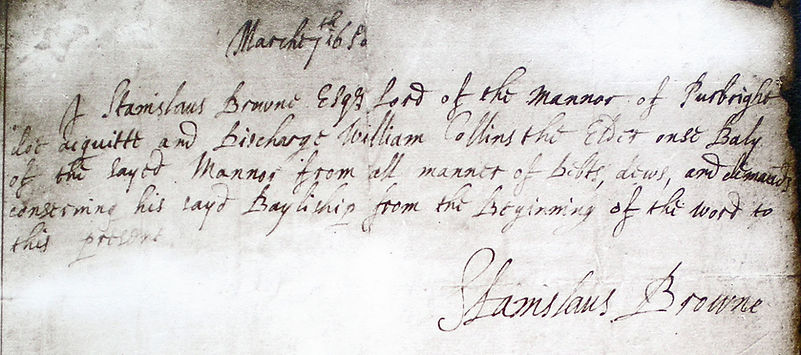
The second document (shown below) from 1652 appoints William Collins as Gamekeeper.
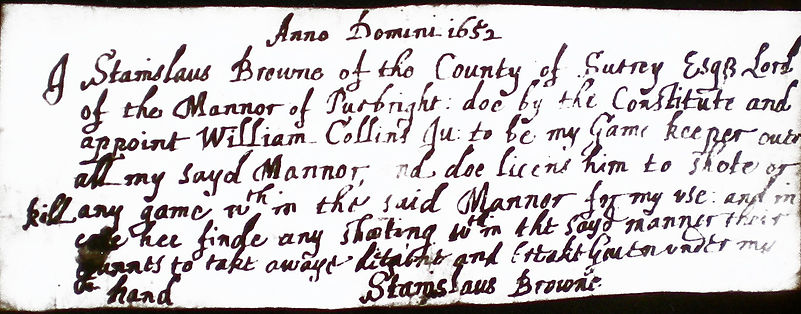
The third document (pictured below) from 1664 permits William Collins to enclose a piece of the common abutting his property at Burners Heath.
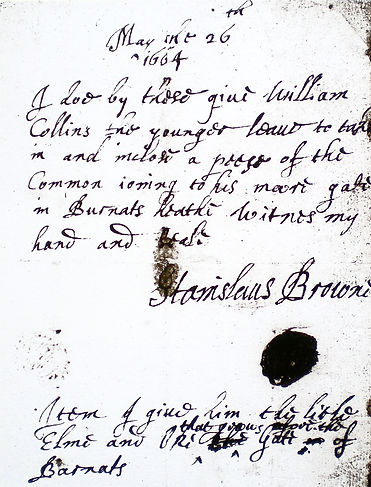
In case you were wondering who William Collins was, we deal with him in the section dealing with Burners Farm. In 1677 Francis sold the lordship of Pirbright Manor to John Glynne 2.
John Glynne 2
We will begin by looking at the new Lord of the Manor’s father, Sir John Glynne 1 (1602-1666). He was the son of a Welsh lawyer, who himself was the son of a Welsh lawyer. Sir John had sat in the House of Commons from time to time between 1640 and 1660. Despite being imprisoned in the Tower of London for nearly a year, he became Lord Chief Justice under Oliver Cromwell. He later changed his tune to favour the Restoration and was knighted in 1660.
Sir John Glynne 1’s first wife was Frances Squibb, the daughter of Arthur Squibb, who had purchased the Manor of Henley in 1631. Arthur Squibb had built a new mansion in the grounds of the previous royal hunting lodge (where Henley Park was later built), but this had nearly bankrupted him. Sir John Glynne helped his father-in-law out by purchasing Henley Park from Arthur Squibb in the 1640s, probably at a generous price. Sir John Glynne 1 died in 1666, still the owner of Henley Park, which at that time was 500 acres in size.
John Glynne 2 (c1650-1682) was the third son of Sir John Glynne 1. When his father died in 1666, John Glynne 2 inherited Henley Park while still a minor. He was educated at Oxford University and became a lawyer.
John Glynne 2 purchased the Manor of Pirbright from Francis, Lord Montagu in 1677 presumably to increase the size of the overall estate, as of course Henley Park and The Manor of Pirbright bordered one another.
In 1679 John married Dorothy Tylney (of Tylney Hall, Hampshire). John and Dorothy lived at Henley Park and had 3 daughters in quick succession: The first, Anne, died in infancy, the third (Elizabeth) never married, and in 1681 Dorothy.
Then John Glynne 2 unexpectedly died in 1682, in his early 30s, leaving a young wife and 2 very young daughters.
After John died in 1682 we think that the Lordship of Pirbright Manor passed to John’s baby daughter, Dorothy. Effectively it would have been held by the late Sir John’s wife, Dorothy, as her daughter’s guardian.
Dorothy in fact remarried the next year to George Woodroffe, who was to inherit an estate at nearby Poyle, and the manor of Cleygate. We suspect that Dorothy and George assumed the role of Lord of the Manor of Pirbright as guardians for Dorothy until she reached her majority (in 1702). George died in 1713, but we are not sure when Dorothy died.
Dorothy Glynne and Sir Richard Child
John Glynne’s daughter, Dorothy (born 1681), married Richard Child in 1703, having just inherited the Manors of Henley in Pirbright. Richard Child (1680-1750) was the 3rd son of Sir Josiah Child (1630-1799), 1st Baronet of Wanstead and Governor of the East India Company. Sir Josiah had held a significant stockholding in the company and so it is no surprise that he died a very wealthy man (his will including codicils ran to 26 pages of tightly-packed script). Pictures of Sir Josiah and Richard Child are shown below.
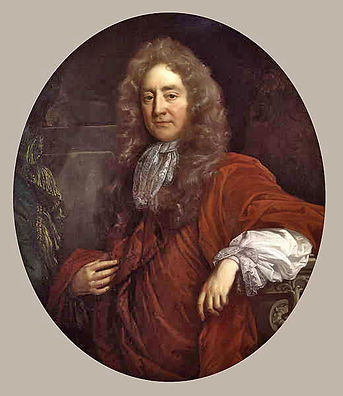
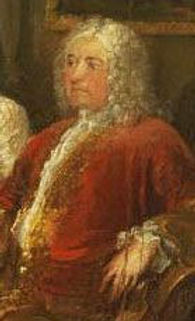
Although Richard was Josiah’s 3rd son, his 2 elder half-brothers died in 1698 and 1704 respectively. Richard therefore had the luck to inherit his father’s title and estate at the ripe old age of 23, just a few months after his marriage. Richard inherited an income of £10,000 pa (£1.8 million today). The couple chose to live in Wanstead, where Richard had grown up.
Richard became an MP for Maldon, Essex. He used his immense fortune to build a massive Palladian mansion, Wanstead House (which has since been demolished). In 1718 Sir Richard was created Viscount Castlemaine, a peerage in the Irish House of Lords, which it was rumoured that he had purchased for £10,000 (£1.8 million today). The title came with no tangible benefits, merely status – but it seems that social status was fairly important in Richard’s eyes.
In 1730, Dorothy inherited further Tylney family estates in Hampshire from her mother’s side. In order to comply with the terms of the relevant bequests, Richard arranged for himself to be created Earl Tylney of Castlemaine, another Irish title. He then changed his surname from Child to Tynley by an Act of Parliament, so that he and his wife could inherit the estates in full.
The Child/Tylney couple never lived at Henley Park, and it seems unlikely that they ever spent any time in Pirbright either. In 1739, they decided to sell both to a gentleman called Solomon Dayrolles. Richard died in 1750, but we are not sure when Dorothy died.
Solomon Dayrolles
Solomon Dayrolles (c1710-1786) came from a French Huguenot family, who had emigrated to England. But we know very few of the family’s details.
[As historical background, in the 1680’s, Louis XIV exercised increasing restrictions on the Huguenots (French Calvinist protestants) in France, and consequently c200,000 people left France for Protestant countries (mainly The Netherlands, England, Germany and Switzerland).
Between 40,000 and 50,000 Huguenots arrived in southern England during the period 1680 – 1710. This was the largest influx of foreign refugees into the UK up to that time, and represented around 1% of England’s population. It is reported that they showed a willingness to work hard, to persevere and to lead frugal lives, and assimilated into local populations well. They were particularly known for their weaving skills].
Solomon had the good fortune to be the nephew and heir of James D’Ayrolles, who was King George I’s resident for some time at Geneva, and from 1717 to 1739 at The Hague. [The monarch’s resident in a country had diplomatic functions, similar to an ambassador today]. No doubt James’s command of the French language helped him in this role.
Solomon was also the godson of Philip Stanhope, 4th Earl of Chesterfield, the wit and politician, through whose friendship the young official obtained speedy advancement in his profession.
James D’Ayrolles died in January 1739, and passed on his estate to Solomon, who promptly spent much of it buying:
-
Henley Park, Mansion and Farm (452 acres)
-
The Manor of Pirbright, including 2 farms and Upper Mill (206 acres)
-
3 small holdings in Normandy.
These are shown in green on the map below, transcribed onto a modern OS map (with thanks to John Squier).

11 years later, in 1750, he bought Cowshot Farm (103 acres, part of Cowshot Manor) from John Kidder, a brickmaker of Worplesdon for £380 (£70,000 today). Together with 2 other purchases he had made, he now owned over 900 acres in Normandy and Pirbright.
Solomon’s career prospered, being sworn as Gentleman of the Privy Chamber (don’t ask) to King George II in 1740, and retaining his place in the court of King George III in 1760. With the old king he quickly became a personal favourite. This helped him become the King's resident at the Hague in 1747, and then promotion to a similar post at Brussels, which he held until 1757. He was elected a Fellow of the Royal Society in 1743 “as a Gentleman of Merit & Learning, well versed in Philosophy and most parts of Natural Knowledge”. We have shown 2 early press cuttings (from 1745 and 1747) announcing Solomon’s promotions below. In case you were wondering, the “United Provinces” refers to what we now call The Netherlands. The “States General” was the central governing body thereof.


In 1751 Solomon (aged c41) married Christabella Peterson (aged 18), daughter of a Colonel Peterson. He was described as “a man of great benevolence and exemplary piety and his manners were the most correct cast of the old school, now so entirely forgotten”. When the couple were in England (ie not on their European residencies) they lived both at Henley Park and at their house in Hanover Square. They had 1 son and 3 daughters.
But Solomon and Christabella did not seem to take much interest in Pirbright. In fact Solomon managed to positively antagonise Pirbright people: He thought he had the right to dig peat on part of the peat moor, and so assigned this right to a Thomas Chilton. Thomas Chilton accordingly started digging peat, which interfered with the tenants’ ability to use the common pasture to graze their horses, cattle and sheep. The tenants brought various legal actions against Solomon to stop this practice, but the various legal processes dragged on for no less than 34 years. Eventually in 1773 an agreement was reached whereby the tenants would receive 40% of the peat profits and 50% of the turf profits.
A letter written by DC Tovey (the Vicar of Worplesdon) in 1910 refers to the Dayrolles family as follows: “His (ie Solomon’s) daughter eloped in 1777 with the son of that Glover who wrote the tedious epic Leonidas, and Walpole was bitterly satirical about poor Solomon. There was an obscure scandal about Mr Stanhope and some one of Solomon’s family”. We can only wonder how the vicar knew this!
Solomon and Christabella’s son, Thomas, seems to have let his father know that he was not interested in inheriting his estates, as Solomon sold Henley Park and the lordship of Pirbright (together with its property) to Henry Halsey in 1784. Halsey also acquired the advowson (i.e. the power to appoint the Rector). Shortly afterwards, Solomon’s son Thomas married a Swiss lady and the couple settled in Switzerland. They had 1 son who died in 1823 without having any children, and thus the Dayrolles male line died out.
Solomon died in Hanover Square in 1786, and Christabella in 1791.
The Halsey family
And so in 1784 began the era of The Halseys. In view of the importance of the Halsey family on the development of Pirbright between 1784 and 1922 we have described their history in some detail on the Halsey Family page. So we will not repeat any of it here.
The Halsey family had a significant effect on Pirbright. In their first 100 years (until 1885), they acquired a great deal of property in Pirbright. But Henry Halsey 4, who had acquired the title in 1885, had expensive habits and hobbies. He soon set about selling his inheritance piecemeal until in 1922 it had virtually all gone. That’s a lot of gambling and drinking. At this point the Halsey influence in Pirbright was reduced to zero, except for the (by then) empty title of Lord of The Manor of Pirbright.
Post-Halseys
We don’t know for sure who was Lord of The Manor after the Henry Halsey 4 in 1937. As he had no sons and 2 daughters, logic would suggest that the title was inherited by the elder daughter, Edwina Caroline Halsey (born 1882). She had married Jean Raoul Audren, Vicomte de Kerdrel, of Chateau de Keraudren, St Pol de Leon, Finistere (of an old Breton family) in 1914. A letter from Edwina in 1948 confirms that she thought she was Lord of the Manor at that time. They had 3 children:
-
1915: John Audray ‘Billy’Audren de Kerdrel
-
1919: Michael Halsey Audren de Kerdrel. Michael was a RAF pilot who was shot down over Munster in 1944.
-
1922: Viscount Jean Andreu.
